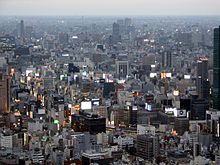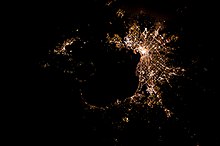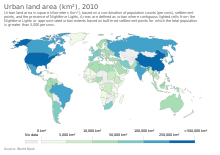
A | B | C | D | E | F | G | H | CH | I | J | K | L | M | N | O | P | Q | R | S | T | U | V | W | X | Y | Z | 0 | 1 | 2 | 3 | 4 | 5 | 6 | 7 | 8 | 9




An urban area, built-up area or urban agglomeration is a human settlement with a high population density and an infrastructure of built environment. This is the core of a metropolitan statistical area in the United States, if it contains a population of more than 50,000.[1]
Urban areas originate through urbanization, and researchers categorize them as cities, towns, conurbations or suburbs. In urbanism, the term "urban area" contrasts to rural areas such as villages and hamlets; in urban sociology or urban anthropology it contrasts with natural environment.[citation needed]
The development of earlier predecessors of modern urban areas during the urban revolution of the 4th millennium BCE[2] led to the formation of human civilization and ultimately to modern urban planning, which along with other human activities such as exploitation of natural resources has led to a human impact on the environment.
Historical growth
In 1950, around the world, 764 million people lived in urban areas. By 2014, it was 3.9 billion. The change was driven by a combination of increased total population and increased percent of population living in urban areas.[3] In 2009, the number of people living in urban areas (3.42 billion) surpassed the number living in rural areas (3.41 billion), and since then the world has become more urban than rural.[4] This was the first time that the majority of the world's population lived in a city.[5] In 2014 there were 7.3 billion people living on the planet,[6] of which the global urban population comprised 3.9 billion. The Population Division of the United Nations Department of Economic and Social Affairs at that time predicted the urban population would occupy 68% of the world population by 2050, with 90% of that growth coming from Africa and Asia.[7]
Urbanization


Urban areas are created and further developed by the process of urbanization. They are measured for various purposes, including analyzing population density and urban sprawl. Urban areas are also mostly found in the United States, Canada, Brazil, Mexico, Argentina, Chile, Japan and Australia and many other countries where the urbanization rate is over 80%.[citation needed]
Unlike an urban area, a metropolitan area includes not only the urban area, but also satellite cities plus intervening rural land that is socio-economically connected to the urban core city, typically by employment ties through commuting, with the urban core city being the primary labor market.
The concept of an "urban area" as used in economic statistics should not be confused with the concept of the "urban area" used in road safety statistics. This term was first created by Geographer Brian Manning. The last concept is also known as "built-up area in road safety". According to the definition by the Office for National Statistics, "Built-up areas are defined as land which is 'irreversibly urban in character', meaning that they are characteristic of a town or city. They include areas of built-up land with a minimum of 20 hectares (200,000 m2; 49 acres). Any areas less than 200 metres are linked to become a single built-up area.[9]
Argentina and Japan are countries where the urbanization rate is over 90% while Australia, Brazil, Canada, Chile, Mexico and the United States are countries where the urbanization rate is between 80% and 90%.[citation needed]
Largest urban areas
There are two measures of the degree of urbanization of a population. The first, urban population, describes the percentage of the total population living in urban areas, as defined by the country. The second measure, rate of urbanization, describes the projected average rate of change of the size of the urban population over the given period of time. According to Urbanization by sovereign state article, the world as a whole is 56.2% urbanized, with roughly one-quarter of the countries reported as greater than 80% urbanized. Data is taken from the U.S. Central Intelligence Agency World Factbook estimates from 2020.[10]
According to Demographia, these are the 200 largest urban areas in the world by population (as of 2023):[11]
| Urban Area | Country | Population | |
|---|---|---|---|
| 1 | Tokyo-Yokohama | Japan | 37,785,000 |
| 2 | Jakarta | Indonesia | 35,386,000 |
| 3 | Delhi | India | 31,190,000 |
| 4 | Guangzhou-Foshan | China | 27,119,000 |
| 5 | Mumbai | India | 25,189,000 |
| 6 | Manila | Philippines | 24,156,000 |
| 7 | Shanghai | China | 24,042,000 |
| 8 | Seoul-Incheon | South Korea | 23,225,000 |
| 9 | Cairo | Egypt | 22,679,000 |
| 10 | Mexico City | Mexico | 21,905,000 |
| 11 | Kolkata | India | 21,747,000 |
| 12 | São Paulo | Brazil | 21,486,000 |
| 13 | New York | United States | 21,396,000 |
| 14 | Karachi | Pakistan | 20,249,000 |
| 15 | Dhaka | Bangladesh | 19,134,000 |
| 16 | Bangkok | Thailand | 18,884,000 |
| 17 | Beijing | China | 18,883,000 |
| 18 | Moscow | Russia | 17,878,000 |
| 19 | Shenzhen | China | 17,778,000 |
| 20 | Buenos Aires | Argentina | 15,748,000 |
| 21 | Los Angeles | United States | 15,587,000 |
| 22 | Johannesburg-Pretoria | South Africa | 15,551,000 |
| 23 | Bangalore | India | 15,257,000 |
| 24 | Chengdu | China | 15,016,000 |
| 25 | Ho Chi Minh City | Vietnam | 14,953,000 |
| 26 | Osaka-Kobe-Kyoto | Japan | 14,916,000 |
| 27 | Lagos | Nigeria | 14,540,000 |
| 28 | Istanbul | Turkey | 14,441,000 |
| 29 | Lahore | Pakistan | 13,504,000 |
| 30 | Kinshasa | Democratic Republic of the Congo | 13,493,000 |
| 31 | Tehran | Iran | 13,382,000 |
| 32 | Chongqing | China | 12,653,000 |
| 33 | Rio de Janeiro | Brazil | 12,306,000 |
| 34 | Xi'an | China | 12,211,000 |
| 35 | Chennai | India | 12,053,697 |
| 36 | Paris | France | 11,108,000 |
| 37 | Zhengzhou | China | 11,068,000 |
| 38 | Luanda | Angola | 10,914,000 |
| 39 | London | United Kingdom | 10,803,000 |
| 40 | Dongguan | China | 10,753,000 |
| 41 | Lima | Peru | 10,556,000 |
| 42 | Wuhan | China | 10,353,000 |
| 43 | Bogota | Colombia | 10,252,000 |
| 44 | Tianjin | China | 10,047,000 |
